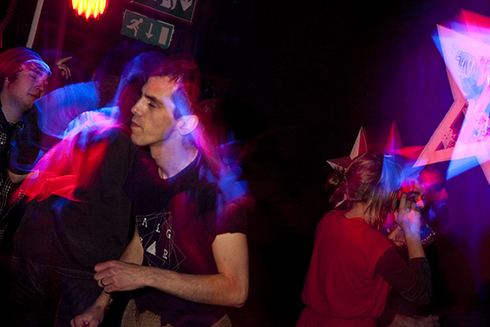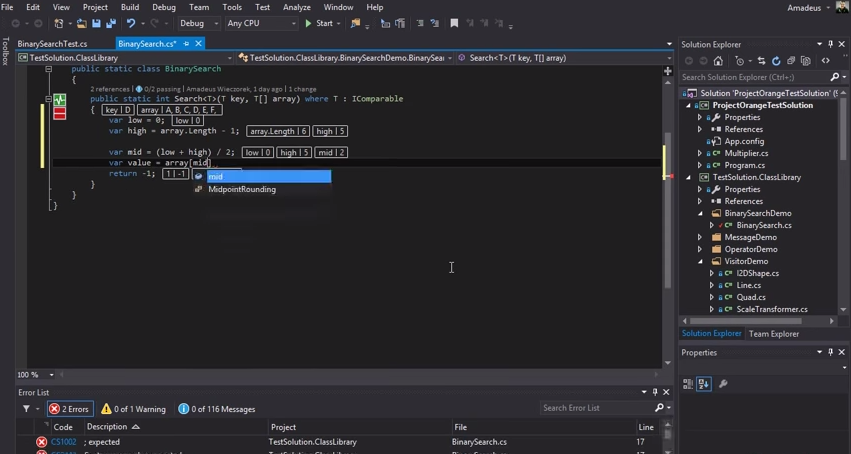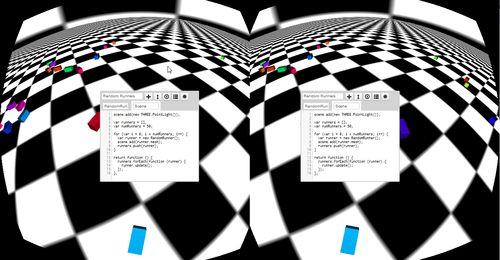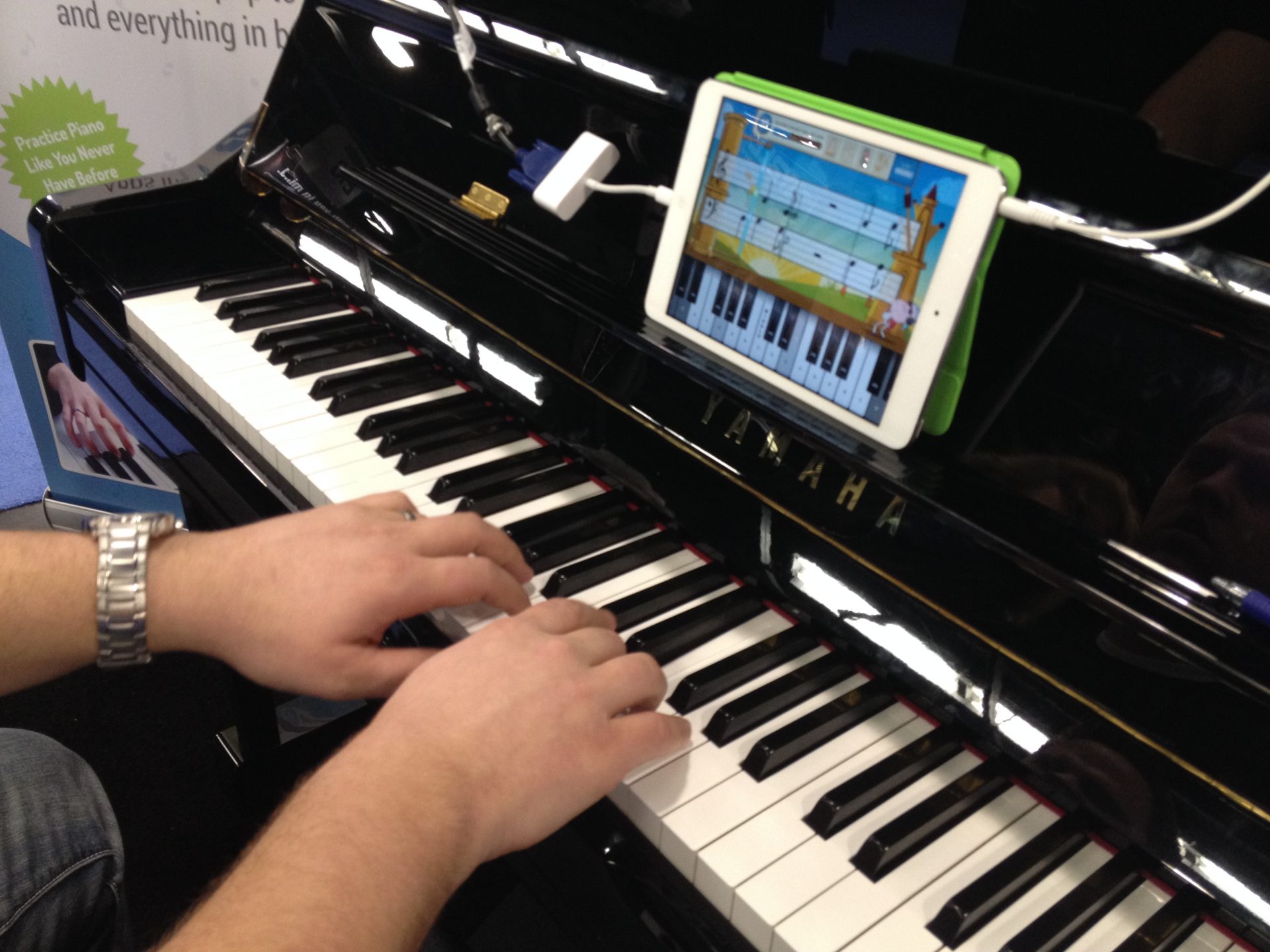A group of people stands in a darkened room staring at a blank screen. A line of code appears, and then another, and another. Disjointed electronic sounds emanate from speakers as a coder behind a laptop onstage builds the code methodically into a coherent rhythm, the code growing more layered and complex with each passing moment. The live coder’s cursor moves frantically from line to line. The audience, their eyes transfixed on the screen, begins to dance.
What’s happening is called an algorave, or at least the first few minutes of one. Algorithmic raves, an offshoot of a type of improvised algorithmic composition known as live coding, are a growing movement among both programmers and musicians. Over the past few years across western Europe and in places like Mexico, Australia, Japan and even as close as Canada, live-coded performances have given electronic artists and bands a way to break through the stand-around DJ culture of today’s electronic music in live, messy fashion.
Live coding isn’t supposed to be completely smooth. Performers are writing code on the fly, often in a programming environment built for live coding or using custom software they’ve created themselves. And by projecting their screen, audience members get to see the sound, and even become active participants, as the performance is created.
“Live coding comes from a reaction against laptop performance in music, where people won’t be projecting their screen, they’ll just be operating software to create music,” said Dave Griffiths, a member of the live coding band Slub who also goes by the stage name NeboGeo. “Half the time they’re playing MP3s and there’s absolutely no engagement with the audience at all. It’s very passive.
“The idea of live coding is to confront that, so when things go wrong, you get a very interesting effect with the audience. Everything goes silent, you see the performer panicking, their mouse is shooting around the code scrolling up and down like, ‘What did I do?’ Then everyone starts looking at the screen and trying to help. I’ve been in performances where people will scream out, ‘You’ve missed a semicolon!’ ”
Slub has been live coding since 2000 with original members Alex McLean and Adrian Ward, and transitioned exclusively to live coding in 2005 after Griffiths joined the band. The commitment to live-coding performances was a way to shift the audience’s focus onto the algorithms creating the art rather than the artists. Audience members seeing a single line of code evolve into complex sound can more easily relate what they’re seeing with what they’re hearing.
“It’s such a ridiculous thing to do, to be in a nightclub, writing software with your screen projected,” Griffiths said. “Actually one of the things I find fascinating is the response you get from other programmers is really like, ‘What’s the point? Why are you doing this? People shouldn’t see this.’ Whereas people who are not programmers, especially musicians or artistic people, are fascinated because they’ve never really seen the process of writing software and they don’t understand that it’s a creative thing.”
Each member of Slub uses his own self-built coding environment. Griffiths, whose background is in computer graphics, uses a custom visual programming language that creates schemes of Lisp code. Instead of using parentheses, it uses custom structures to encapsulate different sections of the code.
Slub performing live at the Electro Anthro Visceral Intensity concert in London in November 2013
Ward uses an IDE called Pure Events, a tracker-like JavaScript environment built in the style of an Excel spreadsheet. He writes a bit of code in each cell, which is timed to trigger in harmony with what Griffiths and McLean are coding.
McLean, who also performs solo under the moniker Yaxu, initially used feedback.pl, a self-editing Perl programming environment. More recently he created a mini-pattern manipulation language in Haskell called Tidal, which flashes the section of code being executed so the audience can see it more clearly.
“A lot of the inspiration comes from pushing technology and seeing how we can build things differently with this completely different emphasis,” Griffiths said. “What I’m seeing increasingly which is really, really interesting is live coders who are musicians. They’re not interested in programming in any other sense than for them as a performance, so they aren’t interested in programming in itself, but they have very much adopted it as part of a musical experience.”
Algoraves are rooted in a 2004 live audio symposium, created by German philosopher and live coder Julian Rohrhuber, called Changing Grammars in Hamburg, Germany.

McLean live coding with Tidal at a performance in York, U.K. in 2011 (Photo courtesy of www.underyourskinphoto.uk)
Early live coders and bands trekked to Hamburg, and what resulted several days later was something called the Terrestrial Organization for the Proliferation of Live Art Programming (TOPLAP), an organization to explore and promote live coding.
“It was recognized that there were people in a few different countries and on a few different platforms trying to live code, and what we meant by live coding was also up for debate,” early live coder Nick Collins explained. “In a smoky Hamburg bar at 2 a.m., we formed TOPLAP.”
TOPLAP has served as evangelist and ambassador for the live coding movement for the past decade, connecting isolated pockets of live coders with the international community, and facilitating meet-ups, concerts, conferences and festivals. Over time, TOPLAP, which was only ever intended to be a temporary organization, has taken a backseat to the more recently formed Algorave organization, which McLean runs.
Origins of an algorave
On a road trip to Nottingham, England between live-coding gigs in late 2011, McLean and Collins, an electronic musician and computer music researcher who performs under the pseudonym Sick Lincoln, invented the concept of an algorave. They tuned into a radio station playing happy hardcore (an upbeat genre of techno music) and decided they wanted to try programming some raves.
“Algoraves were created partly in order to change the emphasis of what people expect,” Griffiths said. “If you put on a live-coding event, people really don’t know what to expect. They’re all standing around stroking their chins trying to work out what’s going on. During an algorave, people come expecting to drink and have fun and dance, and that totally changes the emphasis, which I think is one of the reasons it’s really taken hold.”
The first algorave, March 17, 2012
Algoraves have been described as the meeting point between hacker philosophy, geek culture and clubbing. Many of the performers are live coders, but all forms of algorithmic music are welcome, unlike the more narrow focus of a live coding concert.
The first algorave took place in March 2012 as a warm-up concert for the 2012 SuperCollider Symposium, an international gathering of SuperCollider users (one of the original and most popular IDEs for live coding and algorithmic composition). Among the performers were Slub and Sick Lincoln.
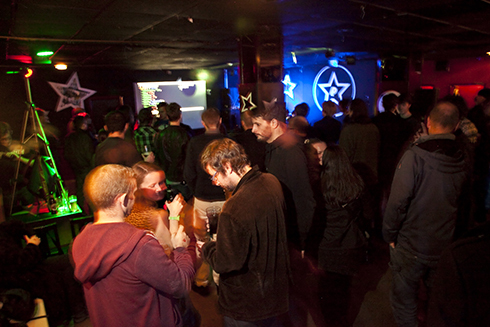
An algorave in Sheffield, U.K. on November 2013 (photo courtesy of www.underyourskinphoto.co.uk)
“I find it a bit bizarre actually these days, because in my mind I’m still somewhere in London in a converted public toilet that has been turned into a bar where there’s only an audience of 25 people,” Collins said. “There’s one really dodgy projector, and you’re trying to play on a really battered sound system. So actually having real music festivals, wanting to have proper club nights of live coding or algoraves, sometimes it’s a little odd… The quirkiness of it keeps it vibrant as a subculture.”
Collins, currently a professor of computer music at Sussex University in the U.K., has done extensive research into live coding and algorithmic music on top of some Web and mobile app development of his own. He’s also been active in developing and maintaining SuperCollider.
A live coder making waves in the U.S.
Live coding has spread to many countries around the world, but it hasn’t quite taken hold in the U.S. Not yet, at least. There are scattered live coders across America, some in New York and California, and some in places you wouldn’t expect.
Mike Hodnick is an independent software developer and live coder living in Minneapolis, where the midsized metropolitan area houses both a growing technology sector and a thriving arts and music scene. The live-coding community is only in its infancy, but if Hodnick has his way, the Twin Cities may well become a hotbed for live coding and algoraves.
“There’s a healthy arts community here, whether that’s galleries or experimental music, and we do have a very healthy programming community as well,” Hodnick said. “So we’ve got the right circumstances, it just needs a little bit of nurturing.”
Hodnick, a veteran C# and .NET programmer and JavaScript Web developer, had no idea what live coding was until this past Thanksgiving. A lifelong drummer and electronic musician, a friend turned him onto live coding and the algoraves going on in Europe, and he’s been going full steam ever since.
“I’ve always had this kind of unique interest in combining sound with code,” Hodnick said. “I don’t look to create something with a catchy melody or a hook. I like to create things that are very dense, rhythmically. Whether that’s layers of rhythms that interact with each other, or something that’s extremely fast and dense and creating sounds that way.”
Hodnick happened across McLean’s Haskell-based Tidal live coding environment, gravitating toward the intuitive, rhythm and pattern-centric nature of Tidal, learning live coding as he corresponded with McLean and other Tidal users over in the U.K. The result is a project called 365 Tidal Patterns, a Tumblr in which Hodnick live codes a new Tidal pattern each day, both to hone his craft and to give people in the Twin Cities an idea of what live coding can be.
A live coding evangelist of sorts, Hodnick recently formed a community and mailing list called the Twin Cities Computer Music group. He has even reached out to local teachers about performing a classroom live coding demo to introduce students to programming, and spoke about live coding at the Twin Cities Code Camp on April 5, where he gave some impromptu performances for attendees between sessions.
“I’m optimistic that I’ll be able to exponentially expose people to live coding and that word will get out,” he said. “Whether it’s people in the Twin Cities or if word spreads elsewhere, I think there’s a lot of potential that programmers and musicians will be interested. I just hope somebody will notice and spread the word.”
A worldwide movement
In November 2012, Griffiths and McLean travelled to Mexico City for the International Live Coding Symposium; Collins had previously attended the Transitio Festival there in 2010. There they were introduced to a vibrant live-coding community and one of its organizers: musician and live coder Alexandra Cárdenas.
“A year or so ago in Mexico City, we had the first international symposium of live coding, and [The National Center for the Arts] invited the guys,” Cárdenas said. “We met them and it was so good for our community to get their opinions on live coding. It opened our horizons and we realized we could do many more things than we thought.”
Cárdenas, who is currently getting a master’s degree in sound studies from the University of the Arts in Berlin, moved from Colombia to Mexico City in 2000 to be a composer and guitarist. Once there, she discovered the open-source software scene and began experimenting with live coding.
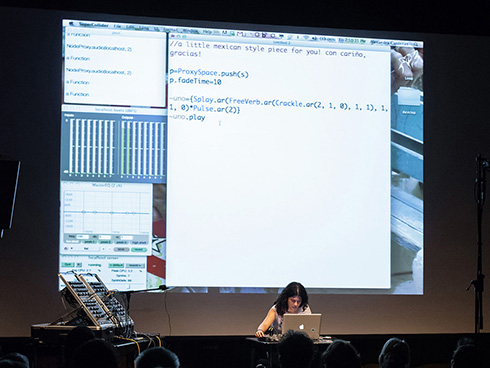
Cárdenas live coding at the live.code.festival in Karlsruhe, Germany, in April 2013
“When I perform as an improviser, I create my musical instrument here on the computer,” said Cárdenas. “I imagine the sounds and I have the power and possibility to create and transform them as I want.”
Cárdenas has performed live coding in the U.K., Germany, Norway and Slovenia, and was one of the first live coders to start performing in Tokyo. She was also the keynote speaker at an international live-coding workshop in Chennai, India this past January, bringing it to yet another corner of the world.
Cárdenas’ “A woman and a snake”
At the behest of McLean, Cárdenas performed at her first algorave in April 2013 on the MS Stubnitz, an old German merchant ship docked at London’s Canary Wharf. Others have organized algoraves, but McLean’s influence is palpable in all of them.
“I think people like the name ‘algorave.’ It puts some emphasis on having fun and not taking yourself too seriously,” said McLean. “I also think non-coders are just interested to see code presented in a different way, as creative material, and not for any purpose apart from making some music for the present moment. We’re still working out how best to make people dance to code. I’ve been working on this problem with the other members of Slub for 14 years now.”
The most recent algorave took place on March 22 in Amsterdam, with algoraves in Porto, Portugal and Barcelona, Spain to follow in June.
No one takes the same path to live coding. Each musician or programmer who stumbles across it comes from a different background, a unique set of circumstances that led him or her there. That’s part of the appeal; it means something different for each performer, and the nature of live coding ensures that each performance is different from the last.
Griffiths came from a computer graphics background. Collins started out as a piano player and composer before getting into computer music in college. Cárdenas studied classical guitar and composition in Colombia before moving to Mexico City.
“There’s an element of live coding, this ambiguity about what’s what,” Collins said. “Sometimes it’s tongue in cheek and sometimes it’s deadly serious. Perhaps that’s part musician humor and part programmer humor, and it’s part of what I hope might be a bit of charm. There’s something almost fatally stupid about attempting to go and program a computer live onstage. I can’t claim that every live-coding gig I’ve ever been to has been packed and playing to mass crowds, but it’s amazing how far it has come.”

